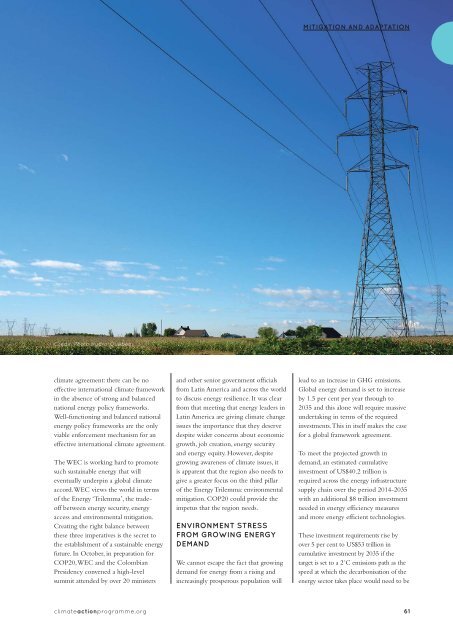Climate Action 2014-2015
You also want an ePaper? Increase the reach of your titles
YUMPU automatically turns print PDFs into web optimized ePapers that Google loves.
MITIGATION AND ADAPTATION<br />
Credit: Photo Hydro-Québec<br />
climate agreement: there can be no<br />
effective international climate framework<br />
in the absence of strong and balanced<br />
national energy policy frameworks.<br />
Well-functioning and balanced national<br />
energy policy frameworks are the only<br />
viable enforcement mechanism for an<br />
effective international climate agreement.<br />
The WEC is working hard to promote<br />
such sustainable energy that will<br />
eventually underpin a global climate<br />
accord. WEC views the world in terms<br />
of the Energy ‘Trilemma’, the tradeoff<br />
between energy security, energy<br />
access and environmental mitigation.<br />
Creating the right balance between<br />
these three imperatives is the secret to<br />
the establishment of a sustainable energy<br />
future. In October, in preparation for<br />
COP20, WEC and the Colombian<br />
Presidency convened a high-level<br />
summit attended by over 20 ministers<br />
and other senior government officials<br />
from Latin America and across the world<br />
to discuss energy resilience. It was clear<br />
from that meeting that energy leaders in<br />
Latin America are giving climate change<br />
issues the importance that they deserve<br />
despite wider concerns about economic<br />
growth, job creation, energy security<br />
and energy equity. However, despite<br />
growing awareness of climate issues, it<br />
is apparent that the region also needs to<br />
give a greater focus on the third pillar<br />
of the Energy Trilemma: environmental<br />
mitigation. COP20 could provide the<br />
impetus that the region needs.<br />
ENVIRONMENT STRESS<br />
FROM GROWING ENERGY<br />
DEMAND<br />
We cannot escape the fact that growing<br />
demand for energy from a rising and<br />
increasingly prosperous population will<br />
lead to an increase in GHG emissions.<br />
Global energy demand is set to increase<br />
by 1.5 per cent per year through to<br />
2035 and this alone will require massive<br />
undertaking in terms of the required<br />
investments. This in itself makes the case<br />
for a global framework agreement.<br />
To meet the projected growth in<br />
demand, an estimated cumulative<br />
investment of US$40.2 trillion is<br />
required across the energy infrastructure<br />
supply chain over the period <strong>2014</strong>-2035<br />
with an additional $8 trillion investment<br />
needed in energy efficiency measures<br />
and more energy efficient technologies.<br />
These investment requirements rise by<br />
over 5 per cent to US$53 trillion in<br />
cumulative investment by 2035 if the<br />
target is set to a 2˚C emissions path as the<br />
speed at which the decarbonisation of the<br />
energy sector takes place would need to be<br />
climateactionprogramme.org 61












